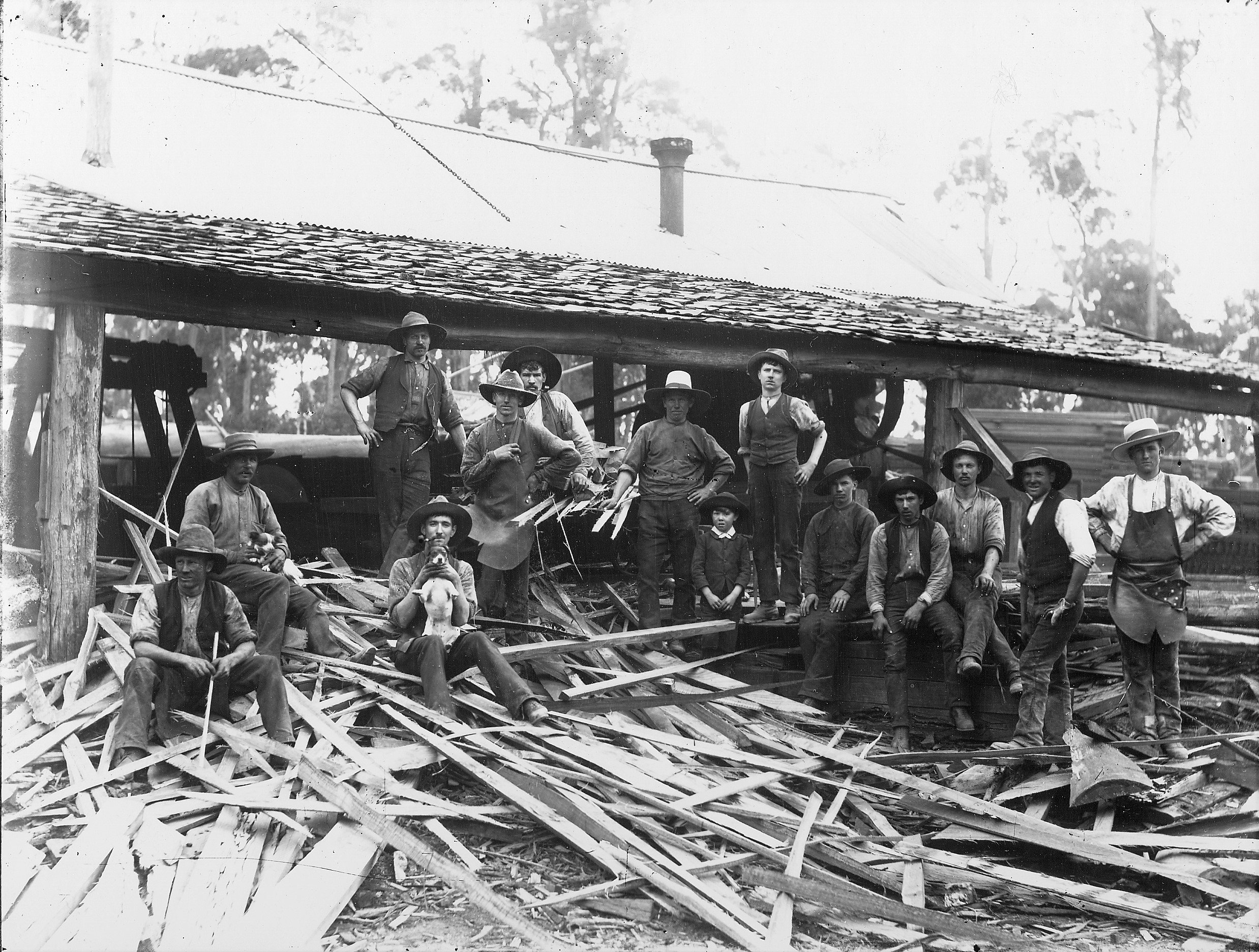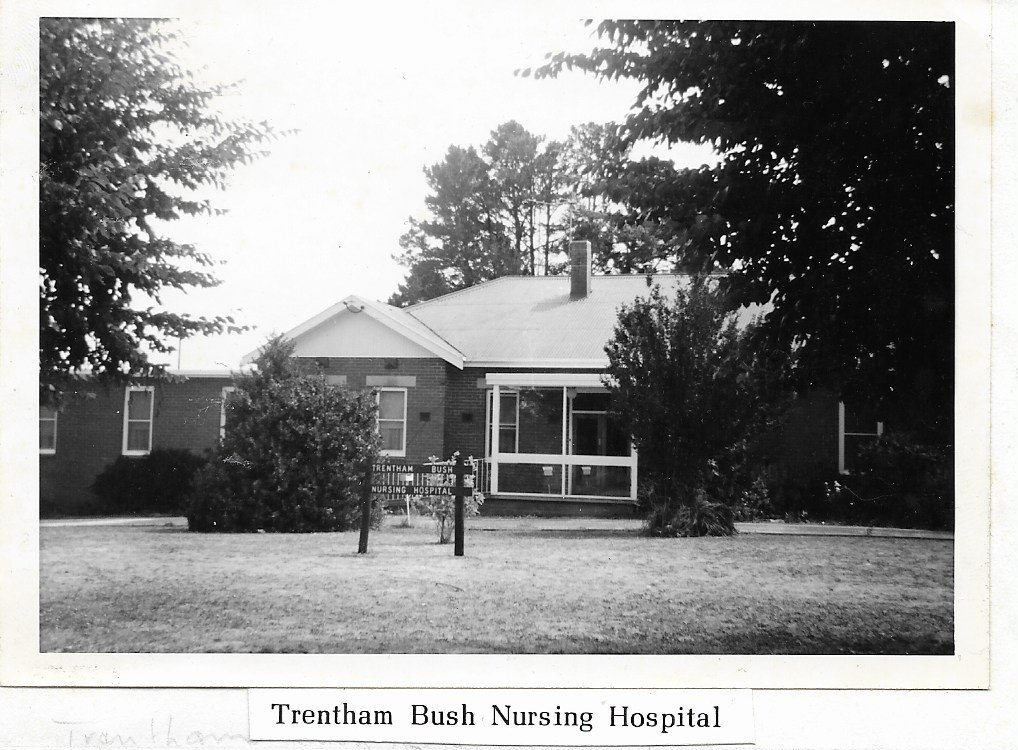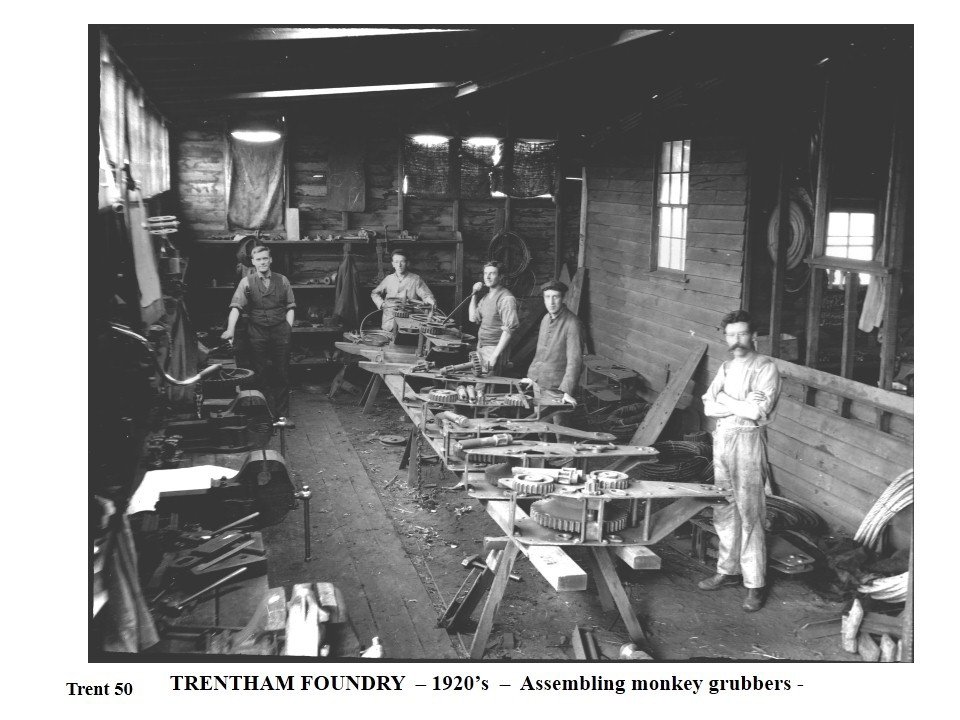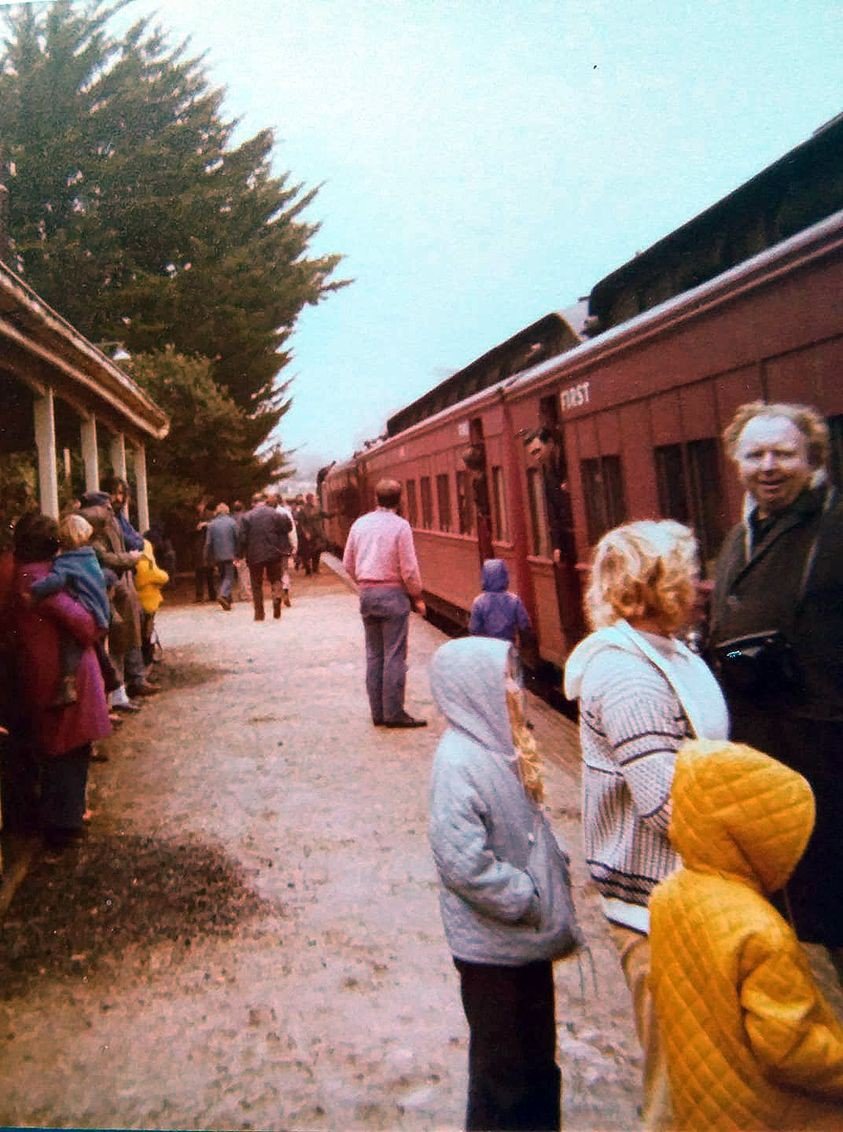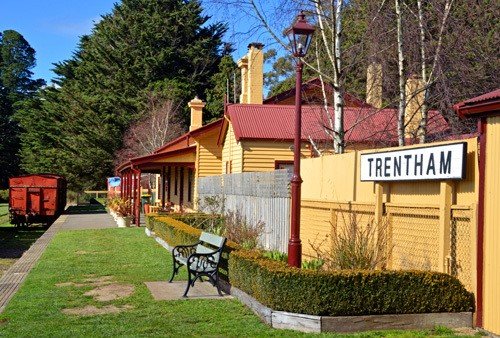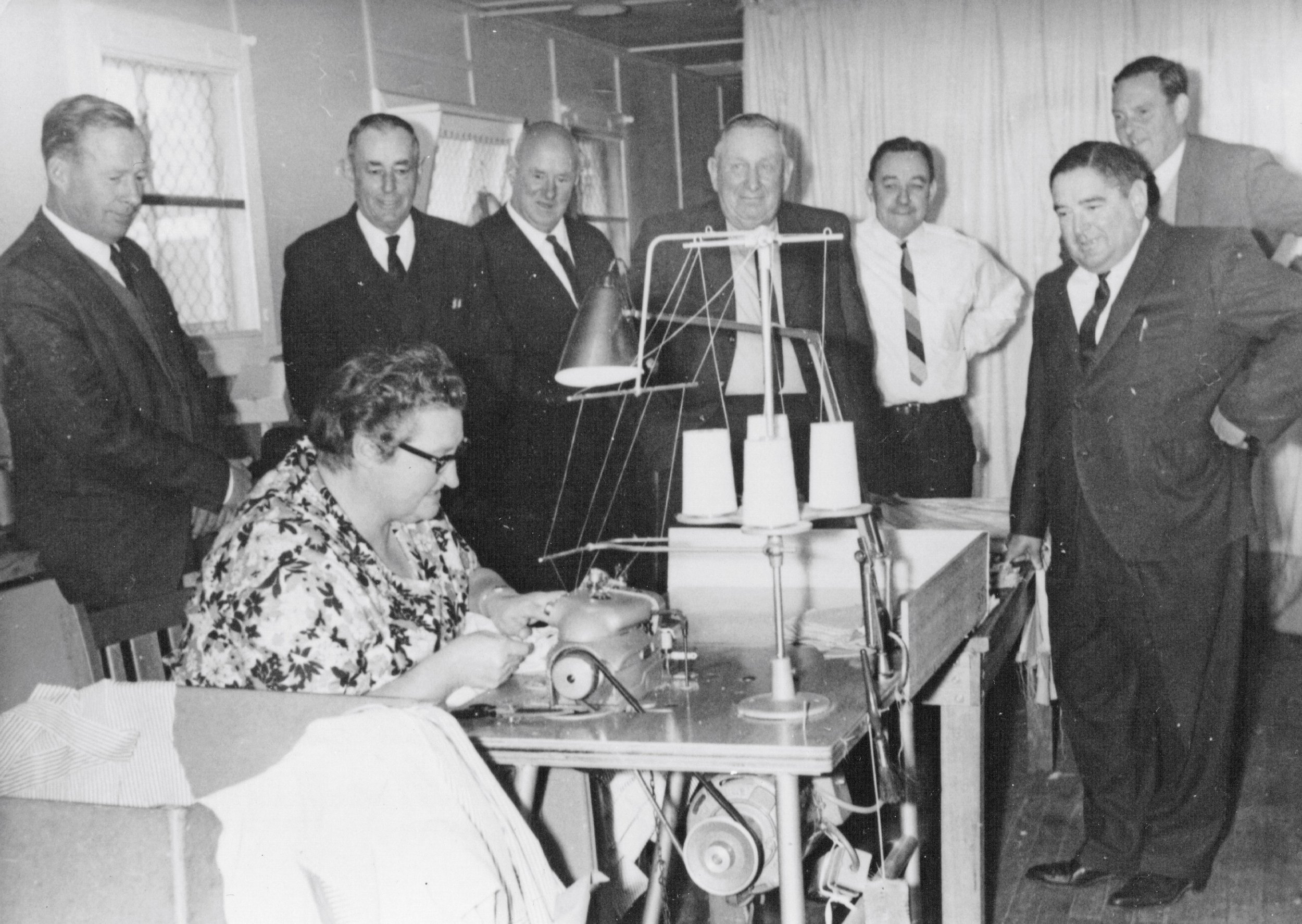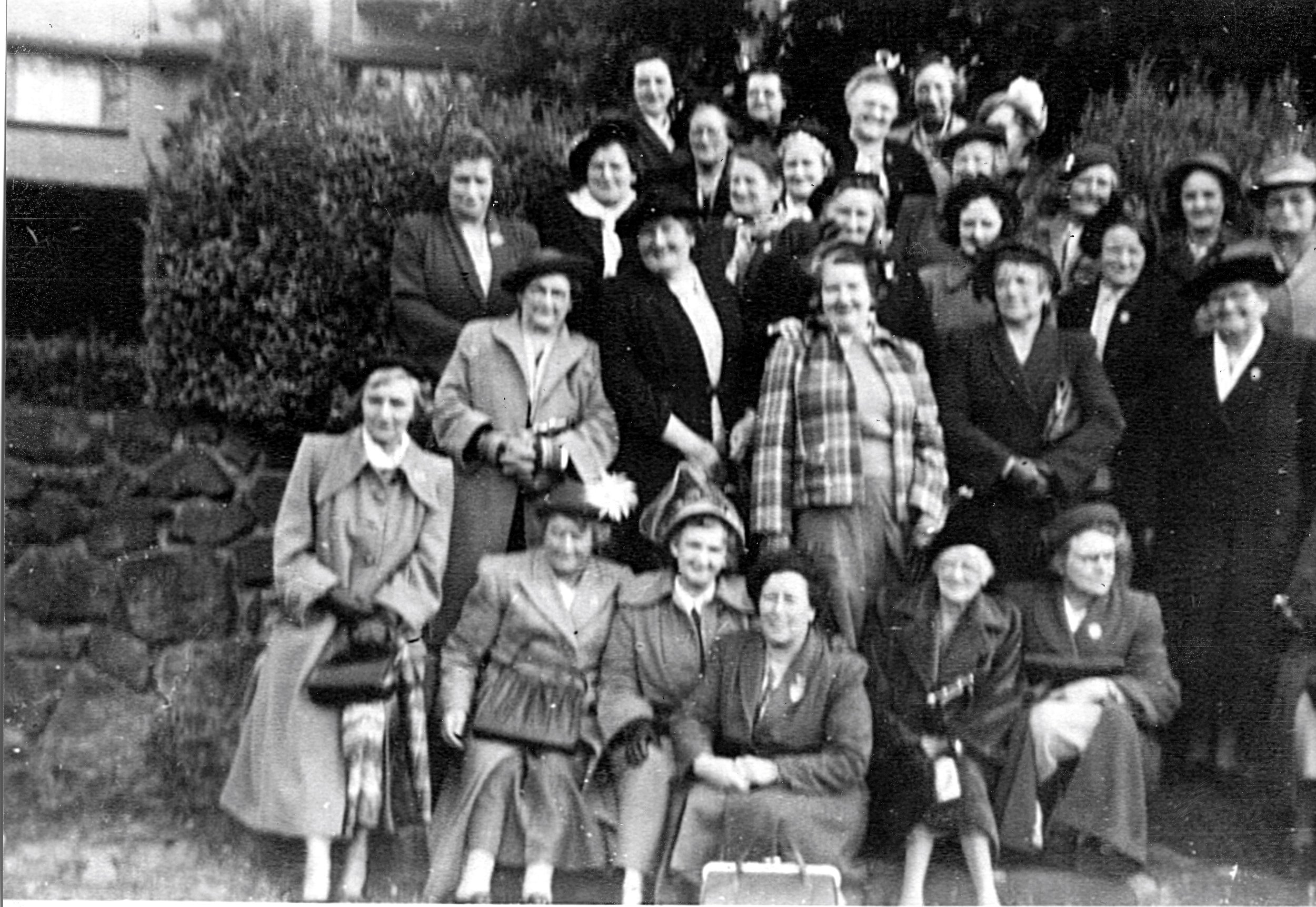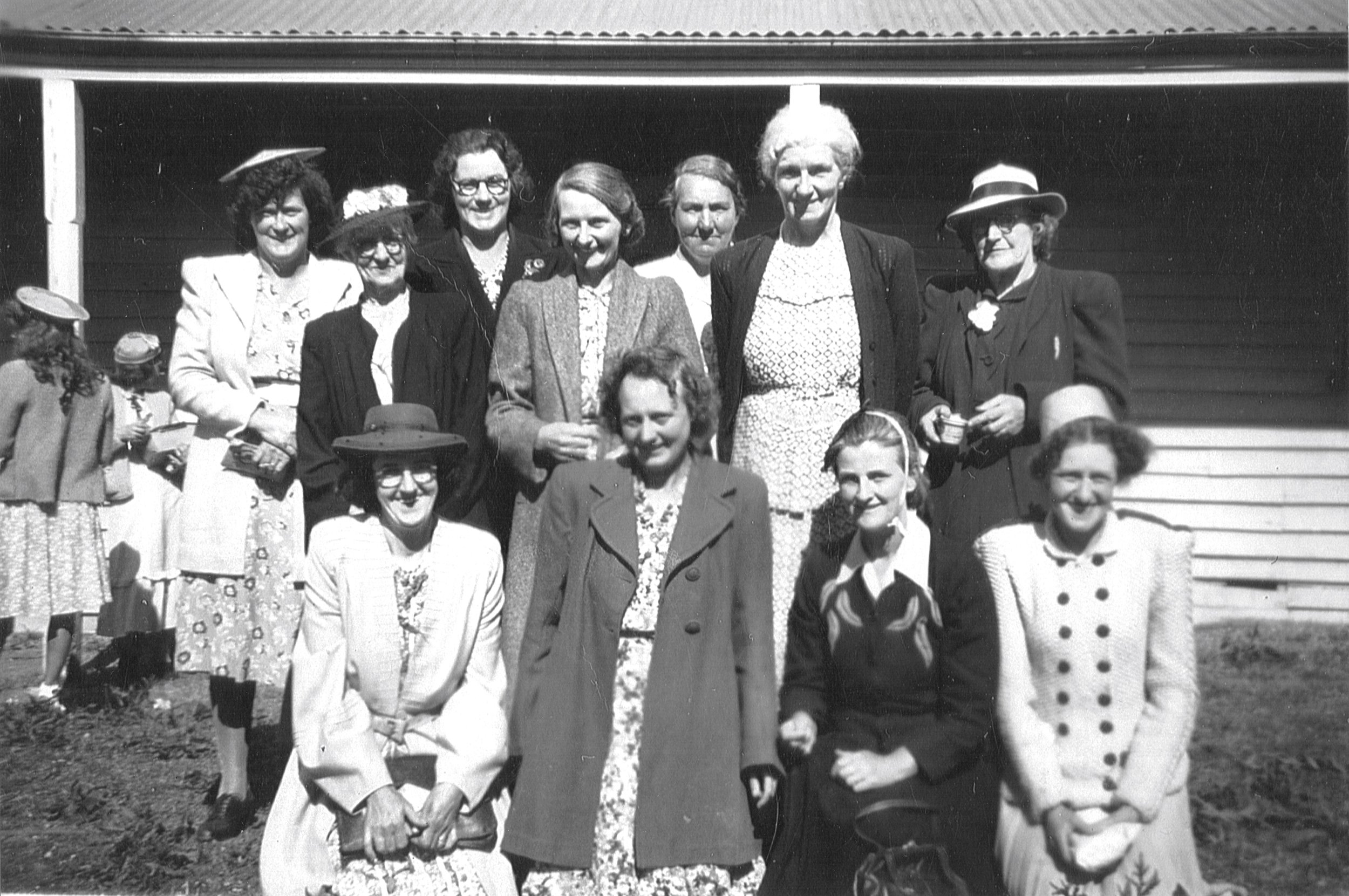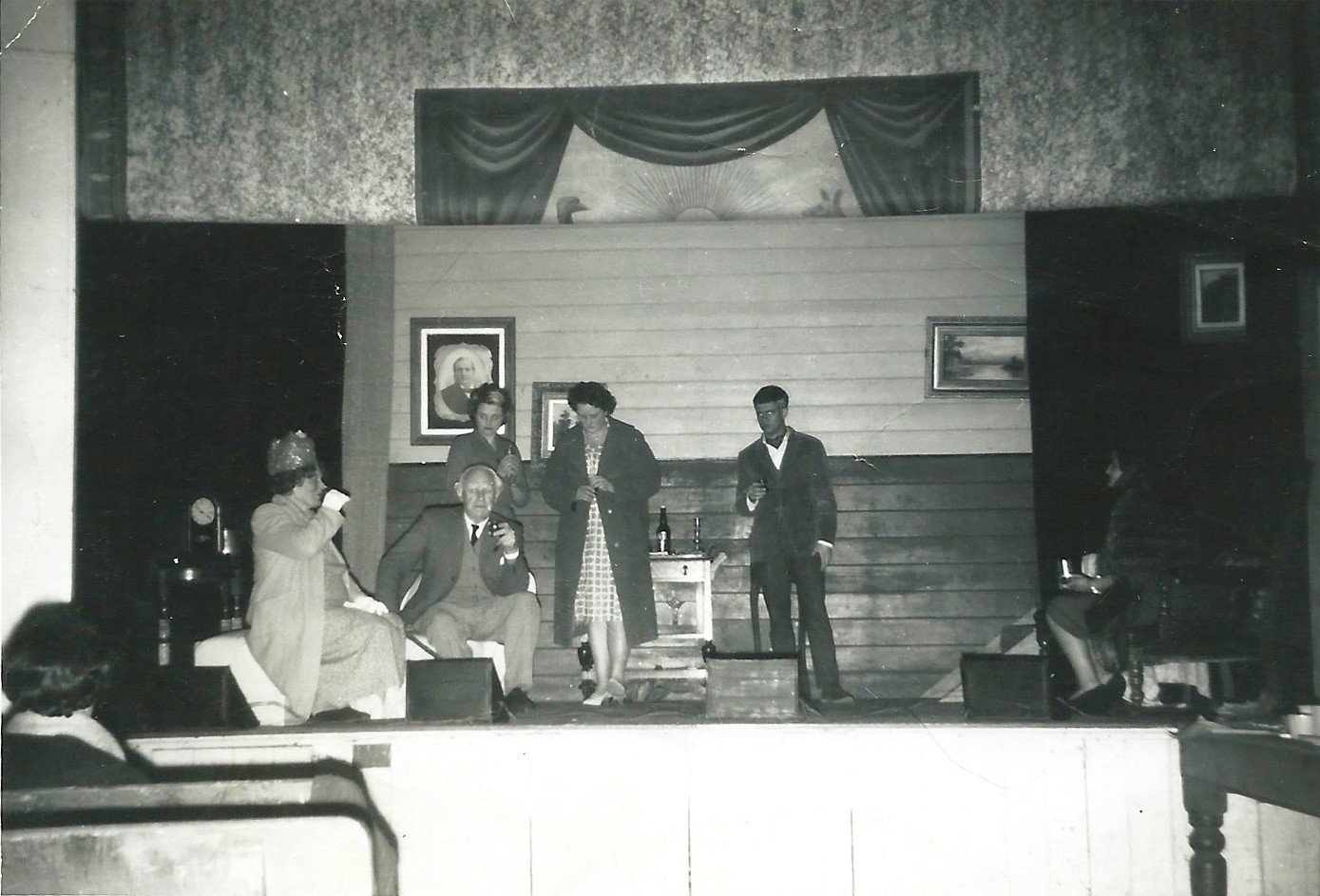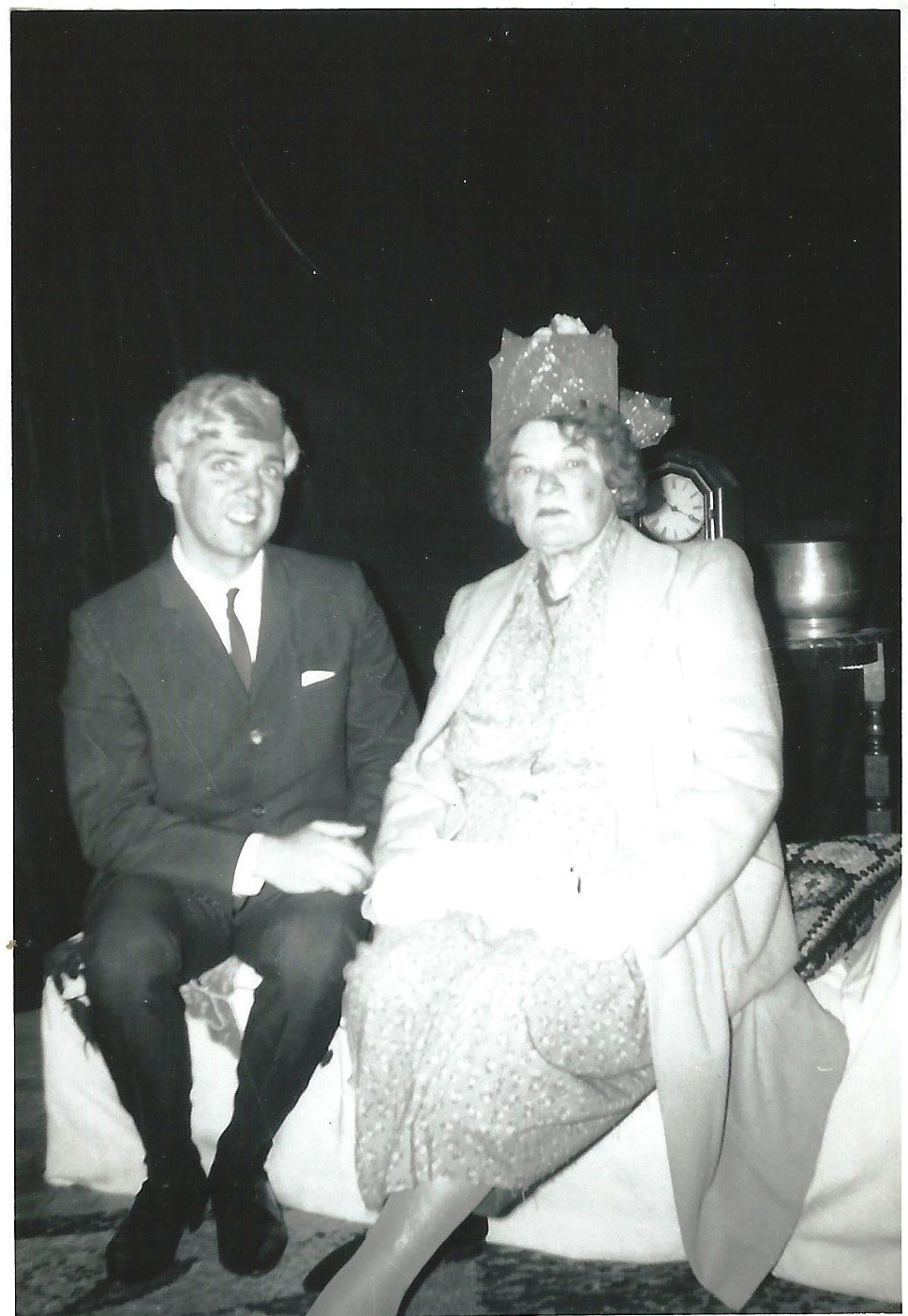The Trentham District Story
Take a walk through the history of the area, starting from the lives of First Nations people through to modern day. Find out about the geological formations that carved the landscape and megafauna that used to roam the once grassy plains.
Hear about the people who shaped the area, how they made a living, and what pastimes they indulged in.
Celebrated here are all those people, industries and events that left a lasting impression on the area and the impact they have had on Trentham and surrounding district.
We would like to acknowledge the many families and individuals who have shared their photos and stories with us. These contributions have allowed us to amass a wide range of material, reflecting the history of the area. We appreciate their generosity, which enables us to display so much of the area’s earlier times with you here.
Trentham Post Office - ANZAC Day
Womindjika Djangi Dja Dja Wurrung Balak
(Welcome to the Home of the Dja Dja Wurrung People)
For Djaara (Dja Dja Wurrung People), Djandak (Country) is more than what is visible to the eye: it is a living entity, which holds the stories of creation and histories that cannot be erased.
Our Ngurari Guli (Ancestors in this area) looked after Djandak here, long before it was called Trentham, and we are duty bound to do the same for future generations. This cold-climate area of Djandak has special significance for Djaara.
It has provided sanctuary and important plant and animal species for thousands of years. Here, we are close to the Country of our Kulin Nation neighbours, the Wurundjeri Woi Wurrung, the Wadawurrung and the Taungurung.
We pay deep respects to all Kulin Nation Elders past, present and emerging, and those of all other First Nations Peoples. We invite you to share Djandak with us, in the hope that we may walk forward together in harmony and in the spirit of healing.
The First Nations panels were developed in collaboration with Dja Dja Wurrung Elder Uncle Rick Nelson and the Trentham District Historical Society. Dja Dja Wurrung Clans Aboriginal Corporation, trading as DJAARA. ICN: 4421. All rights reserved.
First European settlers: 1837-1866
Europeans began living in this area even before Victoria was officially named as a colony in 1851. First they sought land to grow wool for British manufacturers, but expanded their activities to include cropping, logging and sawmilling.
In the process they displaced the First Nations people. Smallpox alone is thought to have reduced the Dja Dja Warrung population from close to 4,000 to less than 2,000 in just 50 years. The decline was intensified by conflict over land. Eventually, they were forcibly re-located.
The discovery of gold in 1854 saw an influx of gold-seekers from around the world, which brought many changes. As a conveniently placed stop between Kyneton, Woodend and the diggings, Trentham developed as supplier for the goldfields – despite its often impassable and isolated roads.
A selection of dates
1837 Malmsbury-based squatter, Alexander Mollison, secured the Trentham district as part of his 'run'.
1840 Mollison sold southern section, plus 1,000 ewes, to Clowes Brothers (Thomas, Robert and Henry) for £20. Their run, Woodside, stretched from Tylden to Lyonville and south to Trentham. Around 100 people lived in the forest from Tylden to Trentham.
1841-1864 Local indigenous people were forcibly moved to the Loddon Protectorate, Franklinford. At its closure, those remaining were relocated to Coranderrk (Healesville).
1854 Gold discovered in Blackwood.
1855 Early maps mark Ogden’s Inn and the Tylden Road. Sawmills and potato farms developing. 1,000 colonists were thought to live in Trentham area, most leaving as alluvial gold depleted.
1857 “Parish of Trentham” surveyed, land sold in 99 to 595-acre (40 – 240 ha) parcels. Ben Trewhella (Snr) and brothers (from Cornwall, England) found gold at Simmons and Sultan Reefs near Blackwood.
1859 Gold found in Trentham. Tylden-Trentham Road Board called for by 13 citizens to address condition of roads made impassable from weather, mining and logging.
1862 Graham McPherson’s store built on High Street, Trentham. Dashwood provided the first Post Office.
1863 Population included 8,000 miners between Newbury and Trentham.
1864 Trentham township surveyed. One acre lots sold. Local farmer, Isaac Pearson, purchased 731 acres east of Trentham, retaining land for a school. Church services held, hotels built.
1865 Bushfires across central Victoria destroyed homes, farms, livestock and livelihoods.
c1860-1910s Chinese market gardens established along High Street at Trent Creek and beyond.
Snow at Ogden’s Mill
Sawmill crew, Wombat Forest, late 1800’s
McPherson’s Store & Post Office, High St
Looking east along High St
Mr H Hines, goldmining at Doctors Creek
Trentham, the growing township: 1867-1890
Trentham became an established colonial township, with a growing spirit of optimism. By the late 1860s the area included 78 farmers, 44 miners, 39 loggers and 20 business owners. The opening of the Trentham Railway Station saw the town become an important logging and potato transport hub, supplying Melbourne’s boom as well as meeting mining demands. By 1891 shops and businesses extended along High Street from Quarry to Bath Streets, and along Market Street to the station. These included at least three grocery stores, bakeries, butchers, blacksmiths and hotels, plus specialist shops and services.
A selection of dates
1867 Township of Trentham proclaimed on 27th April. (Trentham most likely named by surveyor John Wrigglesworth after his hometown of Trentham, Staffordshire, England)
1868 Gold in Alma Reef, about 2 miles (3 km) south of Trentham,
1869 Snake Gully Reef near Newbury sold by J.W.S. Wolff & Co (G. and D.McPherson, P.Murphy, J. Bickley, D.Hanna, C.Hahn, H.McGuiness). for £13,800 (equivalent to $2.2m in 2020).
c1870 Bushrangers Harry Power and Ned Kelly hid in Wombat Forest for several weeks
1876 High Street threatened by bushfires from both Daylesford and Newbury.
1880 Trentham Railway Station opened. Racetrack gazetted.
1881 Mechanics Hall opened.
1884 Rabbit plague. Leading businessman Patrick Murphy (Commercial Hotel) died aged 49.
1886 Rechabite Tent (Temperance League) formed.
1887 Ben and William Trewhella bought James Lyon’s sawmill on Blue Mount.
1888 Boxing Day Races reportedly attended by 3,000 people. Masonic Lodge founded. Trewhella Brothers built the "Wallaby Jack"
1890 In Melbourne, building societies suspend operations as boom turns to crash.
Bullock Team
Fanny, Kit, and Ben Drummond, circa 1885
High St, looking west
Trentham Township c.1880’s
Change, Depression and Disease: 1891-1913
The lengthy Depression that first hit Melbourne in 1890 began to impact Trentham. Sawmills struggled as demand for timber dropped and the government introduced restrictions on overlogging. Falling potato prices led to reduced farming incomes.
Despite the challenges, community sports and recreation flourished: people met for picnics, tennis, shooting, cycling, football and cricket, as well as dances and performances at the Mechanics Institute.
During this time, the Trewhella family's inventions for clearing timber (see "Wallaby Jack" display) became a local and international manufacturing success.
A selection of dates
1890-3 Banks and major financial institutions crashed in Melbourne.
1893 Measles closed the Primary School. (Further measles epidemics 1897, 1906.) William Trewhella set up “Sunnyside Ironworks” in Trentham.
1894 Typhoid epidemic. (Further typhoid epidemics 1898, 1900, 1908). Fire along the north side of High Street. Primary School enrolment, 143.
1897 Population 654. Cycling club opened.
1899-1902 Boer War, British Cape Colony/South Africa. A number of district men enlisted in ‘Bushmen’ mounted regiment. One death: Rupert Thornton.
1900 Drought. Bushfires.
1903 Ben Junior and William Trewhella registered the partnership of “Trewhella Bros – Engineers and Iron Workers.”
1905 Bushfires.
1906 Telegraph service began operation. Bushfires and extreme weather. Roman Catholic brick church built (St Mary Magdalen). Masonic Lodge moved into building on High St.
1907 Whooping cough epidemic.
1908 First public telephone.
1909 Diphtheria epidemic. Trentham Primary School enrolment, 101.
1910 Benjamin Trewhella and John Wolff died. Council improvements at Trentham Falls completed (roads and walks). The Falls were made a permanent reserve in 1914.
1912 Trewhella partnership transformed to Proprietary Limited Company. Piped water to Trentham. Hotel licences restricted to five. Cosmopolitan Hotel became a boarding house.
Ben Trewhella and Family
Trentham 1898
Mechanics Institute Hall
Two World Wars take their toll: 1914-1945
First taxi and probably car in Trentham. Model T Ford, owner E C Wall, Newsagent.
The two World Wars had a lasting impact on the district. In World War I (1914-18) ninety-five locals served: 24 died, many were left disabled, and four families each lost three sons. In World War II (1939-45), 197 served: 12 died, and many suffered permanent injury. On the home-front, those not in service joined voluntary defence corps, endured rationing and shortages, while maintaining farm productivity.
Employment was sustained during and after WWI by the Trewhella Foundry. By the 1920s, potato farmers had come together to fight low prices for their produce, but the Wombat Forest eucalyptus distilling industry, in production since the 1890s, closed. Charcoal burning made a resurgence, even as modern technologies reached Trentham. The 1930s Depression saw unemployment in Australia reach 32%, with as many as 40,000 men roaming the country in search of work
A selection of dates
1914 Typhoid epidemic (other epidemics: 1915 meningitis; 1918 the 'Spanish Flu'; 1939 measles). Bushfires reached railway station. Population 1000+.
1915 Red Cross group formed.
1916 Masonic Lodge purchased and opened building on High Street.
1918 Bridge Street Avenue of Honour tree plantings begun.
1920 Farmers Cooperative began.
1921 First garage opened.
1922 Electricity supplied to the town by Trewhella Foundry.
1923-4 Swimming pool opened in Bath Street.
1924 Population 739.
1927 Postmaster General's Dept purchased land and opened the Post Office in High Street. St George’s Anglican brick church built.. Trentham Primary School enrolment, 90-100.
1928 Rechabite Hall in Quarry Street. Boy Scouts established.
1929 Co-operative store destroyed by fire. Tourist trains introduced.
1930 Country Women's Association (CWA) established.
1931 Yankee Gold Mine re-opened in collaboration with Foundry.
c1932 Population 658.
1933 Walking tours around Trentham advertised.
1934 Bush Nursing Hospital opened. “Back to Trentham” celebrations (25th December 1934 - 1st January 1935), in aid of the hospital, saw 400 visitors for week of sport and festivity.
1937 Golf Club established.
1938 Dr Gweneth Wisewould arrived, becoming Trentham's GP.
1942 Bushfires.
1939 Permanent electricity provided by government. Forest and Station Streets sealed.
1940 School bus from Trentham to Daylesford.
Teenage Gertie Robson (later Giles), wrote welfare letters to soldiers. This was one response: “I received your nice card... You are going for your third year at Kyneton High School... I am going for my fourth of war. I have been at it right from the word go. I was injured at Gallipoli, but been lucky since... I am now in the band, but that does not get us away from the line...we bring up ammunition, water and rations to the front line." (Albert McDougall, Returned to Australia (NSW) in 1919.) (From Bertrand & Robertson "Trentham at War TDHS)
Trentham School 1915
Police Stables 1922
Shirley Trewhella, plane-spotting
Post-war struggles: 1946-1968
For many, the return home from war was a lengthy process, some not reaching Trentham until 1946-47 - one as late as 1949. War had brought irrevocable changes to their society, not least that women were finding their place within the workforce.
The Trewhella Foundry maintained its position as a major employer but moved out of family ownership. A new manufacturer - the Austico Tie Factory (corner of Market and High Streets) - operated for 20 years, providing local employment for young women.
Demand for potatoes increased and, from this time on, itinerant workers regularly returned to dig spuds in season. Forest regrowth and plantation forests enabled the opening of a timber impregnation factory, but gold mines and sawmills continued to close.
Decades of bacteria-based epidemics came to an end, in Trentham as elsewhere, with the availability of penicillin transforming public health.
A selection of dates
1945 Hospital Benefits Act revived the Bush Nursing Hospital.
1947 Monument erected to fallen soldiers, corner of Market and High Streets. Austico Tie Factory opened. Population 705.
1948-9 Tylden Road sealed.
1950s Trewhella Foundry employed 70 people.
1954 Population 762.
1957 Mechanics Institute renovations.
1959 New swimming pool opened in Camp Street. Trentham Sports Club formed.
1961 Population 734.
1964 Foundry sold out of the Trewhella family.
1966 Population 647.
1967 Austico Tie Factory closed.
1968 Dr Gweneth Wisewould published her memoir "Outpost: A Doctor on the Divide". Spring Hill fire destroyed buildings: Trentham township gave a benefit concert hoping to raise $3,000 and made $30,000.
Carting Potatoes
Contraction and uncertainty: 1969-2000
With many businesses and the railway closing, the town entered a period of contraction. Although potato farming reached peak productivity in the 1980s - amongst the highest in the state - demands by big potato processors impacted their ongoing viability.
The East Trentham - Macedon fire complex on Ash Wednesday in 1983 had a dramatic effect on the district. The fire began in East Trentham, covered 29,500 ha, and killed 7 people in the Macedon region. Almost 800 head of livestock were lost, with 628 buildings destroyed.
Ironically, there followed a new awareness of our district as a tourist destination. Local Councillor David Drummond promoted Trentham as “The Hub of Victoria", and the area was on the cusp of discovery by tourists and new residents.
By 1996 community societies and festivals had been established. A new golf club was built and the Lions Club Quarry St Reserve developed.
A selection of dates
1972 Dr. Wisewould died. State Primary School enrolment, 88. St Mary Magdalen’s Primary School closed.
1976 Population 581
1978 Railway closed. National Bank closed.
1983 East Trentham-Macedon bushfire, Ash Wednesday.
1985 Lions Club formed. Medical Centre built. 'Jargon' shop opened (still open in 2023).
1986 Lions Club begins work on Quarry St Reserve. Population 554.
1987 Trentham & District Historical Society formed.
1995 Council amalgamations make Trentham part of Hepburn Shire
1996 Commonwealth Bank closed. Population 658.
1997 Trewhella Foundry ceased operations in Trentham, transferring to Ballarat.
1999 Blue Mountain timber mill closed.
Scala Bros Garage, 1970
Quarry St Reserve
Last train to Daylesford, 24-06-1978
Blacksmith at Trewhella Foundry
Charlie Mayne & Des Wigney, 1968
Plane crash near Trentham, 1984
Trentham - a new identity: 2001-2023
No longer reliant on traditional rural industries, Trentham became an increasingly popular tourist and tree-change destination. During COVID, soaring property prices brought a lack of affordable housing in the previously modest town. By 2022, most major community buildings were undergoing renewal.
A selection of dates
2002 Railway Station precinct restored.
2003 Domino Walking Trail, on former railway line to Lyonville, opened.
2005 Red Beard Bakery opened, using John Wolff's original 1891 Scotch oven. Cosmopolitan Hotel damaged by fire.
2006 Population 629
2007 Easter Art and Craft Show began.
2008 Inaugural ‘Spudfest’ festival, celebrating Trentham’s potato heritage. Local Sustainability group began.
2009 Lions Club monthly Farmers’ Market established.
2010 Aged Care and Medical Centre replaced Bush Nursing Hospital. The Trentham Neighbourhood Centre extended.
2011 Community Bank, Trentham & Districts opened. Cool Country Classic Car Club begun. Monthly "Trentham Trumpet" newsletter. Chef Annie Smithers opened "du Fermier" restaurant. Population 719
2012 Permanent library established. Cosmopolitan Hotel reopened.
2013 Recognition and Settlement Agreement between Dja Dja Wurrung Clans Aboriginal Corporation & State of Victoria.
2015 Wombat Walking Trail around town opened.
2020 COVID lockdowns. Mens’ Shed opened. Post Office moved from PMG building to High Street shopfront)
2021 Major storm event isolated town for days in June, damaging properties and forests. Population 1327.
2023+ Renovations on: Early Learning Centre, Sportsground, Quarry Street Reserve Pavilion and Trentham Community Hub.
2021 Storm clean-up
Covid times, pandemic & lockdowns
Women’s lives: a snapshot
In 1846 Thomas Clowes of “Woodside” married Louisa Tubbs: "The arrival of a mistress made a great difference to life on the station. But it was difficult for a lady reared in the closely settled English countryside to adapt to the loneliness and remoteness" (Ron Clowes). Many women faced such difficulties.
In 1858, Betsey Trewhella (nee Noall), also made the arduous journey from England with her children to join husband Ben on the Blackwood goldfields. At Barry's Reef, in their 2-roomed hut, "Betsey learned to live in a virgin forest, cook and make jam over an open fire, cope with bush fires, bring in tubs of cold water from the yard, and kill snakes. Candles were used for lighting with a hanging paraffin lamp in the living room" (Ben Trewhella Jnr).
In 1859, Charlotte Robson (nee Withell) nursed the sick and delivered babies on her long voyage out, work she continued once settled in the fledgling Newbury community. "There was no help of a doctor, the nearest being at Kyneton, but no mother was ever lost and the only babies lost were those stillborn" (Mabel Trembath, granddaughter).
Daughters invariably provided family domestic support until marriage, with only a few becoming nurses or teachers. When young primary school teacher Maisie Tressider married in 1925, she, like all female public servants until 1966, had to give up work. Subsequently, in 1932, Maisie died giving birth to twins - encapsulating the realities women faced.
For many, rural life of the 1920s & 30s was little better than the 19th century. "My poor mother worked like a slave. We had no mod cons – no washing machine, electricity, running water. Just a good spring nearby that supplied fresh water. She had a terrible hard life" (Frank Brady, Spring Hill).
Domestic routine was set, with or without 'mod-cons'. "Monday was wash day. The copper (washer) was lit early, filled with cold water. As it boiled, my grandmother added soap made from fat and caustic soda. Clothes were scrubbed on a washboard, placed in the copper, stirred with a wooden stick, rinsed in the trough, wrung out by hand, or later the wringer, and hung on the wire clothesline. Washing water was used to scrub the laundry and verandah. Two irons were heated in front of the open fire, or later, on the stovetop for ironing" (June Moloney of her grandmother, Little Hampton).
In 1922 when the Trewhella Foundry supplied electricity to the town, extra power was produced on Tuesdays, "ironing day".
Baking was Fridays: "scones, pies, jam tarts... Initially over an open fire, later a wood stove, then a slow combustion stove". Sugar and flour were bought in bulk, in bags or drums. Empty bags "were made into an apron, kettle holder, or protective cover for the head."
As the 20th century unfolded, postal services, and later telephone exchanges, offered employment for some women. Olive Bruton notably drove her jinker in all weather to deliver the mail between Trentham and Little Hampton between 1933-36. 'Miss Madden' ran the Fern Hill Post Office for years until it closed in 1976.
During World War II, the Women's Land Army exhorted "If you can't fight, farm". In our district there was little choice - agricultural survival depended on our mothers and daughters.
Women also increasingly found employment using their domestic skills. "Mum was an excellent cook, making a good meal from limited resources. She worked as cook at Trentham Bush Hospital and cleaned at private residences" (Jean Smallman's daughter Glenda).
After her 2nd husband's death, Kate Foster, superintendent of St Georges Sunday School for 45 years, ran a boarding house in High Street for young professional women. "We always had a hot 3 course dinner, served in the dining room. At 6 o'clock sharp tea was served, soup and cold meat. On Wednesdays, when the Castles man came to McKenzie’s shop, we had Cheerios (cocktail franks)!" (Margaret Scala, boarder 1956-7).
Interestingly, at this time, it was the Trentham women's football team, the Grasshoppers, that was providing “the best entertainment seen at the Trentham Oval in years” (Trentham Gazette, 25 July 1957).]
While the Trewhella Foundry maintained work post-war for local men (and 2 women, Kit Trewhella and Kath Moloney), between 1946-1963, the Austico Tie Factory provided 25 young women with full time employment: hand sewing, machining, ironing, starching to produce bow ties for major city department stores. "I got 4 shillings for the morning working in homes. At the factory I got £1.10.0 per week - it was a fortune!" (Ethel Patton).
Change was in the air.
Austico Tie Factory
Mrs Betsy Trewhella
Austico Tie Factory: Senior machinist Gwen Ryrie, watched by management, 1950s.
Grasshopper football team.
CWA Members
Austico Tie Factory
Sport & Recreation
Picnics
From 1840s, picnics at local beauty spots were favourite family occasions. In the 1880s, rail tourists flocked to the Trentham Falls and one Sunday there were reportedly 2000 visitors.
Many fished on the Coliban River: "I'd catch so many [trout] down there, I couldn't carry the bag home" (Tom Thorpe).
Sports Days
Organised Sports Days began in the late 1880s. At Trentham Falls, Easter Monday and Boxing Day were annual fixtures, the latter organised by the Catholic Church until 1950s. Competitive events included running races, as well as woodchop, tug of war and climbing a greasy pole.
Swimming
Until the 20th century, locals swam in dams, the Coliban River and Trent Creek, even the base of Trentham Falls. The Trentham Swimming Pool opened in 1923-4. Fed by the 'Chinaman Spring' on Trent Creek, the pool served the community until the mid 1950s. It had its own swimming club, with regular carnivals.
Other amusements
The district’s hotels and later the mechanics institutes, held regular dances and balls as well as concerts, bazaars, fairs, and amateur dramatics.
At Home
Entertainment was self-made: musical evenings and backyard cricket on family occasions
Concert at Trentham Mechanics Hall c.1910’s, photograph by George Hammond
Picnic at Trentham Falls, photograph by George Hammond
Play in progress at Trentham Mechanics Hall,
At Trentham’s first swimming pool, Bath St.
First Trentham Girl Guides, November 1961
Dr Wisewould with John Dommett
Mountaineers Cricket Club, around 1882-1891
Trentham District
Tylden
In 1840, Thomas, Robert and Henry Clowes bought the southern 'Woodside' section of Mollison's original run. This spread across dense forests, through which early settlers logged and ran livestock. Huts and stores sprang up, and Tylden laid the foundations for the district's agricultural industry. The 1880 railway established Tylden's station 3 miles (5km) out of the township, so accelerating the settlement’s already declining prosperity - no longer the transport hub for Kyneton, the original railhead for the Blackwood goldfields.
Buffalo Head Hotel, Tylden
East Trentham
In 1840s-50s predominately Irish settlers recognized the suitability of the rich volcanic soil of East Trentham for growing potatoes. It remained a highly productive potato producing area into the 1980s.
Fern Hill
In the 1840s and 50s European settlers worked areas of 'Clowes Forest’. Messmate, white gum, stringy bark, peppermint and lightwood were cleared. Farmers soon found a ready market in the Blackwood goldfields for staples.
In 1880 the Fern Hill railway station opened and for at least 60 years was a prosperous transport and commercial hub. In 1910 it recorded 2500 outward passenger journeys and dispatched 5000 tons of goods, primarily potatoes, timber and hay.
North Blackwood
This small enclave, south of Pearsons Road, East Trentham, developed in 1870s as selectors moved from Blackwood to the heavily timbered area along what is now Lagoon Road, for logging and milling. Originally known as "Fern Hills", the building of Fern Hill Station, 4 miles (6.5km) to the north, meant the area subsequently had many names.
Spring Hill
In 1830s-1860s tracks ran northwest from Tylden through Coliban (Spring Hill), initially for loggers, then to link the Clowes runs of Wombat (Daylesford) and Holcombe (Yandoit). Spring Hill was en route to Kangaroo Creek diggings and later developed as a stop for those travelling from Little Hampton or Lyonville to and from the Kyneton railhead.
Lyonville
Initially supplying the timber for Ballarat, Lyonville developed into an important late 19th century logging centre. By 1891 Lyonville Station's total outward movement of goods was 10,245 tons, which, after Trentham Station, was the largest in the State. At the turn of the 20th century, the railway also brought tourists attracted by the mineral springs. The demise of timber in the 20th century saw this vibrant community largely disappear.
Little Hampton
In 1860s-70s the original Europeans in Little Hampton were land investors from Glenlyon. Subsequently it became a sawmilling settlement, initially feeding the surrounding goldfields’ insatiable thirst for timber.
Blue Mountain/Garlick's Lead/Newbury
In the 1850s-60s, as gold ran out in Blackwood, miners followed the reefs to 'promising' new fields, such as Garlick's Lead, where the Blue Mountain diggings developed. Settlements along the lead grew to prosperous hamlets as larger, commercial mines opened. When these mines, and the sawmills that serviced them, closed, the villages shrank, and in some areas, like Blue Mountain, gave way to nature.
Fern Hill Store & Hall
A Martine’s store & butcher shop, Spring Hill
North Blackwood
Little Hampton Primary School
Newbury Store
Millers Store, Lyonville
Picnic party, Lyonville
Barry’s Reef
Main St, Barry’s Reef, 1880
Christians Mill
Glenn’s Store & Butchery
Weatherhead’s Sawmill
Yankee Mine 1930’s
FLORA, FAUNA AND GEOLOGY OF TRENTHAM AND DISTRICT
500 million years ago, eastern Australia lay deep beneath the ocean and 250 million years ago, Australia was joined to Antarctica, with the South Pole in central Australia. The land north of Greendale (25km south of Trentham) rose 200 metres and a tongue of ice moved down the Coliban valley carrying boulders and debris. Some 38 million years ago, earth movements formed mountain ranges, with volcanic eruptions forming Mt Macedon, Blue Mount and Cranneys Hill. Water courses were formed where gold and gemstones are found and lava flow from Spring Hill produced a glassy rock, called tachylyte, which first nation people used for axe heads and spear points. When this lava flowed onto wet ground, steam bubbled up, forming basalt with cavities, known as scoria
The gold-bearing gravels came from quartz reefs which mainly developed in the Barry’s Reef (10 km south of Trentham, where gold was discovered in 1858) and Blackwood districts. Through a mix of alluvial and reef mining for gold, some diamonds and sapphires have also been found. Old gold mine shafts exist around Trentham, the main leads being along Lelant Street to Blue Mount Road, and from the Anglican Church to the Old Police Station.
The Trentham Falls formed around 2.5 million years ago when a volcanic eruption deposited lava to a depth of 30 metres in the Coliban River, also known as Garlick’s Creek. Cooling and contracting lava formed basalt columns at the Falls and then small cracks, widened by weather and plant roots, created weakness between the columns helping the river cut back into the rock.The force of water continues to wear and dislodge rock. During the 1916 floods when 381 mm (15 inches) of rain fell in one week in the catchment, the roar of the Falls was heard 2.5 km away in Trentham. The base of the Falls is littered with blocks of rock and the cave behind the Falls is covered by basalt and the white gravel that appears to be emerging from under the basalt is the old pre-volcanic bed of the Coliban. This watercourse formed a canyon running north from Blue Mount to the Upper Coliban, Lauriston, and Malmsbury Reservoirs
The landscape elements of Australia have existed for at least 90 million years, with climatic changes having a profound effect on the vegetation, from humid forests during the Tertiary period (66 to 2.5 million years ago) to today’s flora and fauna. The animals of prehistoric Australia were among the most unusual that ever lived and since splitting from Antarctica 34-50 million years ago, the continent’s fauna has taken its own evolutionary path, with the majorityof its mammals, reptiles and amphibians endemic to the continent. Australia’s prehistoric giants disappeared between 45,000 and 10,000 years ago, coinciding with the arrival of the first Australian aborigines, who coexisted with animals like the marsupial lion and the last grazing diprotodons. A mix of human arrival and ancient climate change, particularly increasing aridity, resulted in the disappearance of much of Australia’s megafauna.
Prior to European settlement, the Wombat Forest/Macedon Landscape contained a diverse range of forest and woodland vegetation. Foothill forests were common on the higher slopes of the Great Divide, with small patches of wet, riparian forest along the creeks and rivers. Valley grassy and plains grassy woodland were found in the lower lying areas.
Trentham Falls, after the storm, photo by Jane Herbert
The valley of the Coliban, above the Falls.
Flora and Fauna
"George Augustus Robinson in 1840 observed the area [around Trentham] as one of a fully mature cool climate forest teeming with life. Beneath this grew native grasses on undisturbed soil where the blackberry – introduced by the botanist Ferdinand von Mueller as a food source and protection against creek-bed erosion – had not yet gained a foothold. Hollow trees provided shelter for possums, koalas fed on manna gums while swamp wallabies, kangaroos, echidnas and wombats took refuge in the heavily wooded forest tracts. Rivers such as the Lerderberg offered a wide variety of freshwater fish and shellfish. Birdlife was abundant, while the call of the mopoke and powerful owls could be heard over long distances."
"Robinson’s journal and local anecdotes confirm that one of the most distinctive features of the forest were the vast tracts of mature trees and grassland that gave an open, almost park-like feeling long before sawmilling triggered the cycle of young eucalypt regrowth that clogs any working forest. Local man Dickie Plant recalled that as a child he could ride a horse at full gallop through the bush. As the campfires of the Dja Dja Wurrung disappeared, the campfires of the earliest bush mills almost immediately took their place. This Eden, as both Major Mitchell and George Augustus Robinson had called it, was only an axe blade away from the 20th Century."
Extracts from "Charlie's Book - the life and times of a country town", Lynn Sunderland, Melbourne University Press, 1999
Over 900 indigenous plant species have been recorded in the area, with fifty-four species now listed as threatened. The local plants have been a major part of the diet of the Dja Dja Wurrung people for thousands of years. Murnong (Yam Daisy) is prized for its potato-like tubers; seeds from trees such as Wai Wai (Golden Wattle) and Ngarri (Sheoaks) can be eaten raw, while young, while seeds like Bawatj (Kangaroo Grass and Wallaby Grass) are ground into flour for damper. Berries from plants like Girrkitj (Ruby Saltbush) and Dhurrungmil wawitj (Appleberry) were consumed from the plant or added to meat for seasoning
Hardy sedges (referred to collectively as witji) were crafted into baskets, bags, mats, traps and for sewing animal skins together. Many plants were used as medicines such as Dirik (Old Man Weed) for a cold or fever and, for more complex illnesses like arthritis, Ngarri was used.
While the first nation people used the vegetation for shelter, food and culture, the white settlers used it as resource with little regard to the consequences. The bark of messmate, peppermint and manna gums have been used for roofing and frost protection of bagged potatoes and the timber used for shingles, coal burners, lining gold mine diggings and construction of roads and houses.
The 70,000-hectare Wombat State Forest was proclaimed in 1871 and the government announced its intention to proclaim it the Wombat-Lerderberg National Park in 2021. This is still to be formally legislated. The latest update on this comes from Mary-Anne Thomas in June 2025, suggesting that the required legislation "will be introduced to Parliament as soon as practicable in 2025."
Much of the forest was logged extensively following the mid-1800s gold rush. By 1884, there were 36 sawmills in operation in the Wombat and Bullarook Forests, the wood being shipped to Melbourne and around Victoria.With little or no regeneration, the 1890s Royal Commission described it as a "ruined forest" and for the next 50 years, the forest was closed to mining and logging, to allow it to regenerate.
A large diversity of indigenous vertebrate fauna occurs in the area, with over 290 species recorded. Thirty-six mammal species inhabit the area, with seven now listed as threatened. 213 bird species (40 threatened), 27 reptile species and 14 frog species also exist in the region. Today’s native fauna includes echidna, brush-tailed phascogale, agile antechinus, dusky antechinus, common brushtail possum, mountain brushtail possum, common ringtail possum, koala, common wombat, black wallaby, eastern grey kangaroo, bush rat and swamp rat. Several threatened bird species occur in the forest including the great egret, intermediate egret, grey goshawk, Australian masked owl, powerful owl and square-tailed kite.
Sources: Coliban Water “Smart Gardens for a Dry Climate”, Wombat Forestcare “Native Fauna”
Want to help support the Trentham & District Historical Society?





